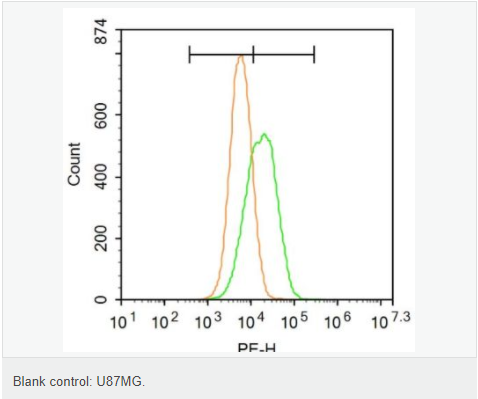
货号
产品规格
售价
备注
BN41951R-50ul
50ul
¥1486.00
交叉反应:Human(predicted:Mouse,Rat,Dog,Pig,Cow,Horse) 推荐应用:WB,Flow-Cyt,ELISA
BN41951R-100ul
100ul
¥2360.00
交叉反应:Human(predicted:Mouse,Rat,Dog,Pig,Cow,Horse) 推荐应用:WB,Flow-Cyt,ELISA
| 英文名称 | SLC26A4 |
| 中文名称 | 钠碘单独转运蛋白SLC26A4抗体 |
| 别 名 | PDS; deafness, autosomal recessive 4; DFNB4; EVA; NSRD4; Pendred syndrome; Pendred syndrome homolog; Pendrin; S26A4_HUMAN; SLC26A4; Sodium independent chloride/iodide transporter; Sodium-independent chloride/iodide transporter; Solute carrier family 26 member 4. |
| 研究领域 | 细胞生物 神经生物学 信号转导 转录调节因子 通道蛋白 细胞表面分子 |
| 抗体来源 | Rabbit |
| 克隆类型 | Polyclonal |
| 交叉反应 | Human, (predicted: Mouse, Rat, Dog, Pig, Cow, Horse, ) |
| 产品应用 | ELISA=1:5000-10000 Flow-Cyt=1ug/test not yet tested in other applications. optimal dilutions/concentrations should be determined by the end user. |
| 分 子 量 | 93kDa |
| 细胞定位 | 细胞膜 |
| 性 状 | Liquid |
| 浓 度 | 1mg/ml |
| 免 疫 原 | KLH conjugated synthetic peptide derived from human Solute carrier family 26 member 4:301-400/780 <Extracellular> |
| 亚 型 | IgG |
| 纯化方法 | affinity purified by Protein A |
| 储 存 液 | 0.01M TBS(pH7.4) with 1% BSA, 0.03% Proclin300 and 50% Glycerol. |
| 保存条件 | Shipped at 4℃. Store at -20 °C for one year. Avoid repeated freeze/thaw cycles. |
| PubMed | PubMed |
| 产品介绍 | This gene belongs to the solute carrier 26 family, whose members encode anion transporter proteins. This particular family member encodes a protein involved in transporting chloride, oxalate, sulfate and bicarbonate. Several alternatively spliced transcript variants of this gene, encoding distinct isoforms, have been described, but the full-length nature of some of these variants has not been determined. [provided by RefSeq, Jul 2008]. Function: Sodium-independent transporter of chloride and iodide. Subcellular Location: Membrane; Multi-pass membrane protein. Tissue Specificity: High expression in adult thyroid, lower expression in adult and fetal kidney and fetal brain. Not expressed in other tissues. DISEASE: Defects in SLC26A4 are the cause of deafness autosomal recessive type 4 (DFNB4) [MIM:600791]; also known as vestibular aqueduct syndrome (EVA). DFNB4 is a form of sensorineural hearing loss. Sensorineural deafness results from damage to the neural receptors of the inner ear, the nerve pathways to the brain, or the area of the brain that receives sound information. DFNB4 is associated with an enlarged vestibular aqueduct. Similarity: Belongs to the SLC26A/SulP transporter (TC 2.A.53) family. Contains 1 STAS domain. SWISS: O43511 Gene ID: 5172 Database links: UniProtKB/Swiss-Prot: O43511.1 Important Note: This product as supplied is intended for research use only, not for use in human, therapeutic or diagnostic applications. |
